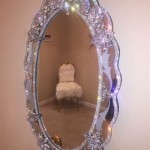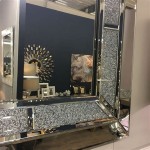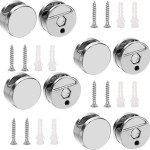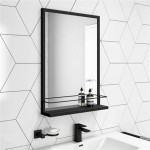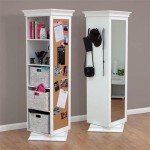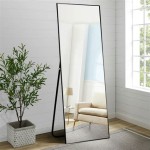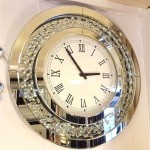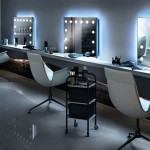How to Use Mirrors to Make a Room Look Bigger
Mirrors possess a unique ability to transform the perception of space within a room. Strategically placed mirrors can create the illusion of depth and expansiveness, making even the smallest rooms feel significantly larger. Understanding how to leverage the reflective properties of mirrors can dramatically enhance the visual appeal and perceived square footage of any space.
One of the most effective ways to utilize mirrors for this purpose is to position them opposite windows. A mirror placed directly across from a window reflects the natural light pouring in, amplifying the brightness and creating a sense of openness. This technique is particularly beneficial in rooms with limited natural light sources, as it effectively doubles the impact of the existing window, giving the impression of a second window and expanding the perceived dimensions of the room.
Large mirrors are particularly effective at creating a sense of depth. A strategically placed oversized mirror can visually double the size of a room, making it feel considerably more spacious. Consider leaning a large mirror against a wall or mounting it horizontally to maximize its impact. This technique is especially useful in narrow hallways or smaller rooms where wall space is at a premium.
Mirrored furniture offers a subtle yet effective way to enhance the illusion of space. Pieces like mirrored console tables, chests of drawers, or bedside tables can add a touch of glamour while reflecting light and creating a sense of depth. These pieces work well in smaller spaces where a large mirror might overwhelm the room, offering a more understated approach to expanding the perceived area.
Mirrored walls can create a dramatic and impactful transformation in a room. While covering an entire wall with mirrors can be a bold choice, it can create a striking illusion of expansiveness, particularly in smaller rooms like bathrooms or powder rooms. If a full mirrored wall feels too overwhelming, consider using mirrored tiles or panels to create a more segmented and less intense effect.
Positioning mirrors near light sources, whether natural or artificial, maximizes their reflective properties. Placing a mirror near a lamp or chandelier can amplify the light within the room, creating a brighter and more open atmosphere. This technique also enhances the decorative effect of the light fixture, as its reflection adds depth and visual interest to the space.
Using multiple mirrors in a room can create a visually intriguing and spacious effect. A gallery wall of varying sized and shaped mirrors can add personality and depth to a wall, reflecting light and creating a dynamic interplay of reflections. This approach can be especially effective in hallways or dining areas, adding a touch of artistic flair while enhancing the perception of space.
Incorporate mirrors into existing architectural details to maximize their effect. Positioning a mirror above a fireplace mantel or within a recessed alcove can draw the eye and create a sense of depth within these features. This technique uses the existing architecture to enhance the reflective qualities of the mirror, creating a seamless integration and maximizing the impact on the perceived space.
The shape of a mirror can also influence how it impacts the perception of space. Round or oval mirrors can soften the lines of a room and create a sense of flow, while rectangular or square mirrors can enhance the feeling of height or width, depending on their orientation. Consider the existing shapes within the room and choose mirror shapes that complement them to create a harmonious and balanced aesthetic.
Avoid placing mirrors opposite cluttered areas or undesirable views. Mirrors reflect everything in front of them, so positioning a mirror opposite a cluttered area will only amplify the sense of disorder. Similarly, placing a mirror opposite an undesirable view, such as a blank wall or a messy storage area, will only serve to highlight these less appealing aspects of the room. Careful consideration of what a mirror will reflect is essential for maximizing its positive impact.
Experimenting with different placements and sizes of mirrors is crucial to finding the optimal arrangement for each individual space. The size and layout of a room, as well as the existing décor and furniture, will influence the effectiveness of mirror placement. Trying different locations and observing the resulting effect on the light and perceived space will help determine the most effective strategy for enhancing the room's dimensions.
Consider the style and frame of the mirror to ensure it complements the existing décor. The frame of a mirror can significantly impact its overall aesthetic and how it integrates with the room's design. Choosing a frame that complements the existing style and color palette will ensure the mirror enhances the room's overall aesthetic while also contributing to the illusion of increased space.
Using mirrors strategically can be a powerful tool for transforming the perceived size and atmosphere of any room. By understanding how to leverage their reflective properties and considering the existing features of the space, it is possible to create a dramatic illusion of expansiveness and brightness, even in the most compact areas.

11 Ways To Use Mirrors Make Your Space Look Bigger

7 Ways Mirrors Can Make Any Room Look Bigger Sonoma

7 Ways Mirrors Can Make Any Room Look Bigger Sonoma

20 Creative Ways To Use Mirrors That Will Make Your Space Look Bigger

7 Ways Mirrors Can Make Any Room Look Bigger Sonoma

11 Ways To Use Mirrors Make Your Space Look Bigger

How To Use Mirrors Make A Room Look Bigger

Do Mirrors To Make A Room Look Bigger

How To Make A Room Look Bigger With Mirrors Storables

Modern Use Of Mirrors To Visually Enlarge Small Spaces Binswanger Glass

